boat near Capurganá
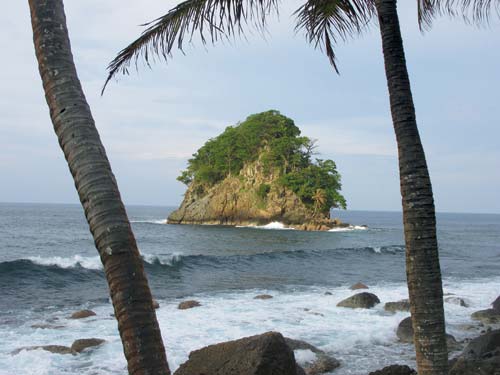
island off the coast of Capurganá.
The portion of the Caribbean coast that stretches west from Cartagena is less visited and familiar than the region to the east. That may be just the ticket for those yearning to explore the undiscovered and escape the crowds.
From Cartagena, this area extends west to the Golfo de Urabá and then juts north through the Darién Gap and the border with Panama. The Golfo de Morrosquillo is home to the beach towns of Tolú and San Antero, as well as the inland city of Montería. Across the Golfo de Urabá, the tropical rainforests of the Darién provide an exuberant backdrop to the seaside towns of Capurganá and Sapzurro, which are accessible only by boat or plane. The diving off the coast here is superb.
What most visitors remember and cherish about a visit to this remote part of Colombia is being immersed in truly wild nature.
Most of the destinations in this region can be visited in one or two days. The exception is the Islas de San Bernardo, where 2-3 days is ideal, and the Darién villages of Capurganá and Sapzurro, where it’s better to give yourself 3-4 days, thanks to the plethora of hiking and diving opportunities.
Tolú and Coveñas are easily accessed by bus from Cartagena. To get to the Darién, consider flying at least one way (into Acandí or Capurganá), to maximize your travel time, as reaching this area by bus and boat takes a while. Flights into the area originate out of Medellín only.
Getting around in this region requires patience and time. Expect fewer buses, limited air connections, and weather-delayed boat departures. From December to February, the coastal waters are at their choppiest, so boat delays are inevitable.
This region was greatly affected by violence during the worst years of the armed conflict between paramilitaries, guerrillas, and the military, with civilians often caught in the middle. This was especially so in the remote areas of the Darién, which was a major drug-trafficking route. Although drug smuggling and related skirmishes in inland areas continue to this day, the places covered in this guide are safe. It’s never a bad idea to ask locals about the security of an area, especially if you venture to parts not described in this guide.
South of Cartagena, the Golfo de Morrosquillo is a broad, 50-kilometer-wide (31-mile-wide) inlet. Largely unknown to international visitors, the gulf’s easternmost shore is home to the beach community of Tolú, which is popular with vacationing Colombian families. Off its shores are the Islas de San Bernardo, with beautiful coral reefs and the world’s most densely populated island, tiny Santa Cruz del Islote.
On the southern edge of the gulf is the town of San Antero, which is home to a crocodile preserve on Bahía de Cispatá. Outside of San Antero is peaceful Río Cedro, a place to truly disconnect from the world. Inland from San Antero is the region’s major city, Montería, in the heart of Colombia’s cattle country.
Balmy beachside Tolú, 160 kilometers (100 miles) southwest of Cartagena, is best described as sleepy. Here, locals get around on foot or bici-taxi (bicycle cab), and it’s hot and humid year-round. The beaches off the mainland are pleasant, but many visitors come here in order to catch a boat to the Islas de San Bernardo.
In the evening, when the mercury has dropped a few degrees, locals congregate in the main plaza to exchange gossip and people-watch. On weekends, the town becomes more lively, with a steady influx of weekend warriors. Along the boardwalk that parallels the beach, vendors sell ceviche, bars blast music, and kids splash around in the warm water.
Tolú is home to a few decent beaches, perfect for lazing in the sun. Check out laid-back Playa El Francés, five kilometers (three miles) north of Tolú. Another option is Punta Bolívar, nearly 30 kilometers (17 miles) southwest of Tolú.
S Villa Babilla (Cl. 20 No. 3-40, Tolú, tel. 5/288-6124, www.villababillahostel.com, COP$45,000 s, COP$90,000 d) is the best place to stay in Tolú by a long shot, with its garden courtyard and serene atmosphere. Rooms have no TV or air-conditioning. A kitchen is available for guest use and there is an Olímpica grocery store a couple of blocks away. Nearby roosters may disturb your sleep.
Catering mostly to Colombian families and groups, Camino Verde (Playa El Francés, Tolú, tel. 5/288-5132 or 5/249-9464, www.vacacionescaminoverde.com, COP$270,000 d) is six kilometers (3.7 miles) east of Tolú, and is a peaceful (but not fancy) spot to relax during the week, despite its sprawling size. Room are generally set up family-style, with a double and a twin bed. Most visitors drive here.
There is frequent bus service from Tolú to Cartagena (3 hours, COP$30,000) and Montería (2.5 hours, COP$25,000). Buses to Cartagena and Montería are at Calle 15 where it intersects Carreteras 2A and 3A.
ADA (www.ada-aero.com) flies from Medellín to Tolú, making this a quick, easy, and often inexpensive beach destination.
To get around Tolú, take a bici-taxi (bicycle cab).
The easiest and least expensive way to spend some time on the turquoise waters of the Golfo de Morrosquillo and relax on a tropical white-sand beach is to visit the Islas de San Bernardo. These islands, located about 16 kilometers (10 miles) offshore, are part of the Parque Nacional Natural Corales del Rosario y San Bernardo, although the islands have been privately developed.
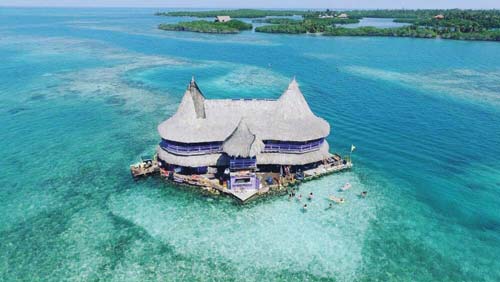
Casa en el Agua in the Islas de San Bernardo
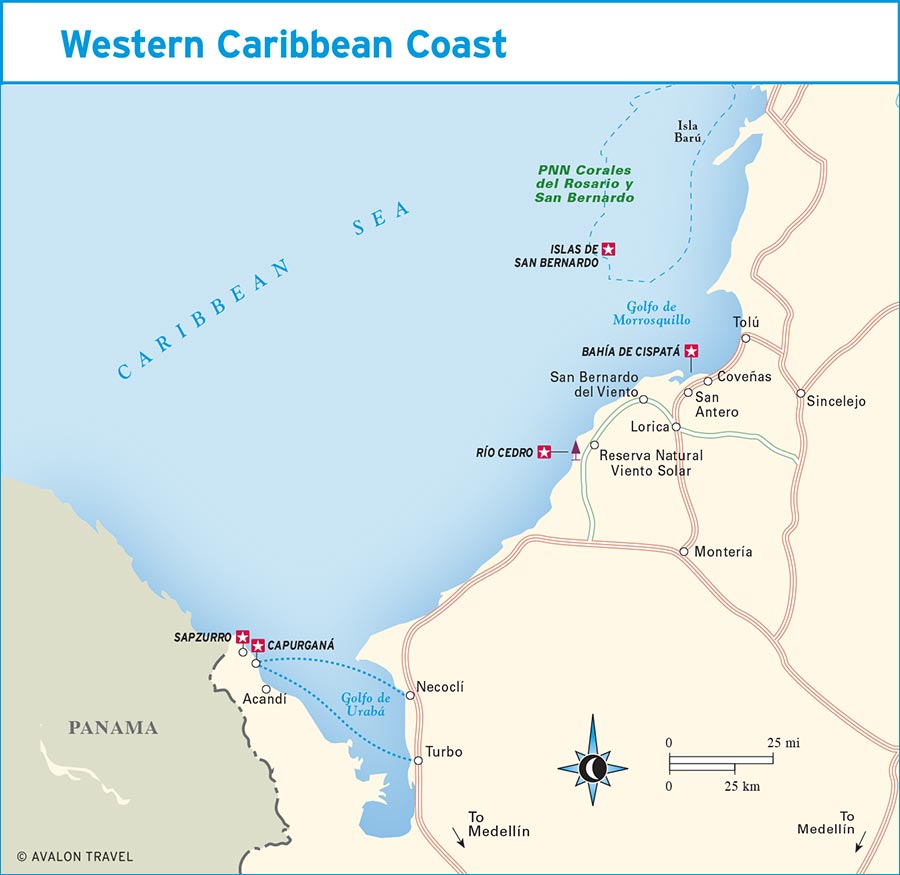
A day tour is a good way to see the islands, and generally includes a stop for a seafood lunch, snorkeling at Isla Múcura, and passing by a handful of the other islands, including Santa Cruz del Islote, the most densely populated island in the world, with one person for every 10 square meters. Book a tour of the islands with Mundo Mar (Av. 1 No. 14-40, Tolú, tel. 5/288-4431, www.mundomar.com.co, COP$60,000 pp), a reputable tour agency. Other tour agencies are located in the hotels that line Tolú’s boardwalk. Most day tours depart at 8:30am and return to Tolú by about 4:30pm each day.
S Punta Norte (Isla Tintipán, cell tel. 310/707-4005, www.hotelpuntanorte.com, COP$195,000 pp), on Isla Tintipán in the Islas de San Bernardo, is run by a friendly Uruguayan and is most often referred to as Donde El Uruguayo, or “The Uruguayan’s Place.” Bring plenty of insect repellent to this remote island paradise. Accommodations are not luxurious, but it’s a relaxed place. The restaurant includes all meals, and fresh lobster is part of the deal! It takes about an hour to get to the hotel from Tolú by boat (COP$40,000). When you make your reservation, inquire about transportation timing and availability.
For white-sand beaches, warm aquamarine waters, and the occasional calorie-loaded cocktail, go to the resort of Punta Faro (Isla Múcura, cell tel. 317/435-9594, www.puntafaro.com, COP$1,190,000 d), an island resort in the Islas de San Bernardo. There are 45 simple rooms with no hot water in the showers and unreliable Wi-Fi. All meals (included) are served buffet-style. Spend your time here lounging on the beach, discovering nearby islands, participating in various water activities, riding bikes, and taking short hikes. It’s a good place to bring kids. Round-trip fast boat service from Cartagena (two hours) costs an additional COP$175,000 per person. You can also depart from Tolú. Punta Faro can assist with transportation to and from the island; inquire when you make your reservation.
For great Caribbean vibes on a floating piece of paradise, head to the S Casa en el Agua (Isla Tintipán, cell tel. 312/756-3439, www.casaenelagua.com, COP$39,000 hammocks, COP$150,000 d), a floating solar-powered hostel near Isla Tintipán. There is a restaurant here, which serves all meals family-style. Activities include diving, island tours, and spearfishing. At night, it’s possible to observe bioluminescent plankton. On nights where there’s a full moon, Casa en el Agua hosts “reef raves.” The quickest and easiest way to get here is via Casa en el Agua’s boat service (1pm Mon., Wed., and Fri., COP$90,000 pp) from Cartagena. You must reserve a spot and confirm departure details in advance. It’s also possible to get here overland, though it requires taking multiple modes of transportation. From Cartagena, take a bus to San Onofre (COP$25,000), a mototaxi to Rincón del Mar (COP$10,000), then a boat (COP$150,000 for four passengers) to the hostel. Or, from Tolú, it’s a 45-minute trip if you hop aboard the island tour boat (8am daily, COP$35,000 pp). Check Casa en el Agua’s website for specific transportation instructions.
The most interesting part of this region can be found along the coastline of Bahía de Cispatá, a serene bay lined with undisturbed mangrove forests, near the town of San Antero. Here, an interesting project by Asocaiman (cell tel. 300/810-1161, www.asocaiman.org, caimanmiranda@hotmail.com) helps in the protection and propagation of American crocodiles and turtles. These creatures were once hunted for their meat and eggs, but today, locals are trained on the importance of protecting these species. A visit to the small bayside refuge, where many species of crocodiles and turtles reside before being released back into the wild, consists of a tour led by a former hunter. There is no set price for the tour, but guides can accept tips. Asocaiman also offers boat tours (COP$15,000-50,000 pp, depending on group size) of the mangroves, during which you’ll have the chance to see animals in their natural habitat. Call Asocaiman in advance to coordinate your visit.
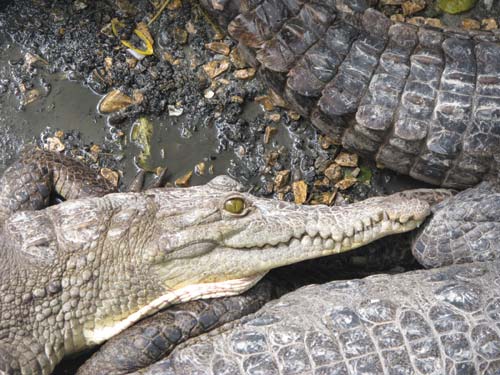
a young crocodile at the Asocaiman conservation center in Bahía de Cispatá
Go eat at S Pesecar (Bahía de Cispatá, cell tel. 312/651-2651, 7am-9pm daily). It’s worth the trip to San Antero just for lunch here—very fresh seafood with an unbeatable bayside location.
San Antero borders the water and has some nice beaches at Playa Blanca. There is a long string of waterfront hotels popular with weekenders from Montería and Medellín. During the week, it’s very quiet. The Cispatá Marina Hotel (tel. 4/811-0197 or 4/811-0887, www.cispata.com, COP$123,000 pp) has an enviable location overlooking Bahía de Cispatá and, on the other side, the beaches of Playa Blanca. The hotel comprises 16 cute red-roofed cabañas as well as smaller apartments. The hotel also has a large pool.
A locally run and quite friendly hotel, the Mangle Colora’o (Vereda Amaya, tel. 4/811-0722, cell tel. 301/203-7071, COP$35,000 pp), is just across the street from Bahía de Cispatá.
San Antero and Bahía de Cispatá are about 30 kilometers (18.6 miles) southwest of Tolú, on the Coveñas-Lorica highway. Regular public transportation is available for under COP$8,000 from the bus terminal along the main highway.
It’s hard to find a place more tranquil than Río Cedro. This community of banana and plantain farmers on a mostly undeveloped coastline in Córdoba, near San Antero, is set amid an unusual tropical dry forest that is home to sloths, howler monkeys, iguanas, and many species of birds. The gray-sand beaches are strewn with driftwood, and pelicans routinely glide by in formation above the usually calm waters.
In peaceful Río Cedro, there are paths galore that wind through the forest and excellent swimming and kayaking opportunities. But perhaps the best activity of all is lazing in a hammock, enjoying the view. Take mosquito repellent.
There are only two accommodations options here. The first, Río Cedro Paraíso Natural (cell tel. 313/718-4015, www.riocedro.com, COP$230,000 pp d, three-night min.) is a single thatched roof cabaña with a 12-person capacity. There are no individual rooms available—the whole cabin is rented at once. A kitchen is available for use, but meal service is also provided.
The second option is the Reserva Natural Viento Solar (cell tel. 317/377-6244, www.vientosolar.org, COP$145,000 pp, all meals included), a private nature reserve with a variety of private and shared rooms. Viento Solar often hosts yoga, meditation, and indigenous healing retreats. Vegetarian meals are provided to guests.
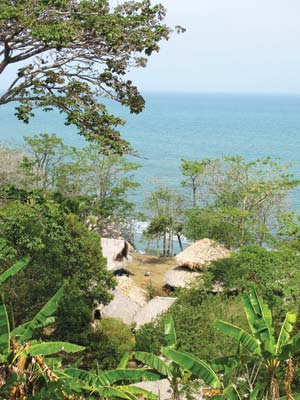
Reserva Natural Viento Solar
Río Cedro is accessible from the town of Lorica, on the banks of the Río Sinú. To get to Lorica from San Antero, take one of the busetas (30 minutes, COP$8,000) that passes through town. From the Tolú-Montería highway in Lorica, take a shared taxi (one hour, COP$8,000) through San Bernardo del Viento to Moñitos—ask a local where to flag one down. From there, both lodges can arrange for a motorbike (45 minutes, COP$10,000) to collect you. Río Cedro Paraíso Natural will arrange from Lorica or Montería for its guests.
Montería, Colombia’s cattle-ranching capital, is a place of urban renewal and civic pride. Despite being 80 kilometers (50 miles) from the coast, it’s a gateway to coastal towns like San Antero, offering the services and comforts of a modern Colombian city. It is not a tourist magnet by any stretch of the imagination; however, this city by the Río Sinú has its charms.
The downtown area is a pleasant place to explore on foot. The Plaza de Bolívar, the city’s main square, is beautiful. Facing it is the prominent white Catedral de San Jeronimo (Cl. 27 No. 2-52). Nearby, the Banco de la República (Cl. 29 No. 2-32, second floor, tel. 4/782-3129, 8am-11am and 2pm-5pm Mon.-Sat.) hosts occasional art exhibits.
For a pleasant walk or jog, head to the Parque Lineal Ronda del Sinú (between Clls. 21 and 38) along the muddy Río Sinú and Avenida Primera. This lovely park under the shade of tall trees and with a view to the river has bike and jogging paths, playgrounds, workout stations, an amphitheater, and juice stalls. This is one of the nicest urban parks in the country.
One of the coolest things about Montería is its ingenious (and ecofriendly) system for crossing the Río Sinú: the planchones. These are small ferries attached to a cable that crosses the river as the captain rows passengers across. This transportation system has been around since 1915. Even though it takes less than five minutes to cross, and there’s not much on the other side, the planchones themselves almost make Montería worth a trip. This simple pleasure costs a whopping COP$500 (under US$0.30).
To get a different perspective on the savanna surrounding Montería, Helicop Aero Tours (cell tel. 315/850-2610, www.helicop.co) offers an array of helicopter tours for all budgets, with some starting as low as COP$185,000 per person.
Along Avenida Primera are several bars and outdoor restaurants where the volume kicks up a notch or two on Saturday nights.
In Montería, the focus is on beef. Many of the town’s popular restaurants are near-sacred tributes to cowboy culture. Bonga del Sinú (Km. 5 Vía Cereté, tel. 4/786-0085, www.labongadelsinu.co, noon-11pm Mon.-Sat., noon-9pm Sun., COP$22,000) is a large restaurant under a thatched roof on the outskirts of the city. To eat like a true cowboy, order the Lomita Bonga Magnum, which is 600 grams (21 ounces) of grilled beef from a variety of cuts. The traditional mote de queso, a hearty cheese soup with ñame (a type of yam) and coconut milk, is a popular choice.
In a nod to the early-20th-century Arab immigration to the area, Montería has a couple of spots where kibbe (ground lamb and bulgur) trumps steaks. A couple of blocks from the river, on a tree-lined street, is Farah Delicias Arabes (Cra. 6 No. 60-42, tel. 4/789-9680, www.farahdeliciasarabes.com, 4:30pm-10:30pm daily, COP$15,000), an authentic Lebanese restaurant. Another option is Baalbeck (Cl. 61 No. 7-16, tel. 4/789-9713, 11am-10pm daily, COP$25,000), where portions are generous and the outdoor seating allows patrons to enjoy the night air.
There is a Juan Valdez Café (Cl. 44 No. 10-139, tel. 4/785-1607, 9am-10pm Mon.-Sat., 10am-9pm Sun.) at the Centro Comerical Alamedas. Get your macchiato fix here—you’re a long way from another decent cup of joe.
Hotels tend to be overpriced in Montería. The Hotel Casa Real (Cl. 29 No. 6-26, tel. 4/782-4004, COP$120,000 d) is a few blocks from Avenida Primera and is also close to a police station. Many rooms are tiny with no windows, but the hotel is within walking distance of the Plaza de Bolívar.
A reliable national chain and recent arrival is the GHL Hotel Montería (Cl. 44 No. 8-43, tel. 4/789-2999, www.ghlhoteles.com, COP$210,000 d), located north of town and adjacent to the Centro Comercial Alamedas shopping mall. There’s a small pool on the rooftop and the hotel is smartly designed with a wink to Caribbean cowboy culture.
A bus ride from Cartagena to Montería’s bus station (Terminal de Transportes de Montería, Cl. 41 No. 20-11, tel. 4/784-9000, www.terminaldemonteria.com) will cost around COP$50,000 and take about five hours. From the bus station, there are easy connections to all nearby coastal towns, such as San Antero (one hour, COP$15,000).
The Darién Gap (Tapón del Darién) is a sparsely populated swath of land, roughly 160 kilometers (100 miles) long and 50 kilometers (30 miles) wide that straddles the border between Colombia and Panama. Its name comes from its interruption of the 48,000-kilometer (30,000-mile) Pan-American Highway, a storied road that extends from Prudhoe Bay, Alaska, to Ushuaia in Patagonia. The highway picks up again in the Colombian port town of Turbo.
The Colombian Darién is bookended by the delta of the Río Atrato that flows into the Golfo de Urabá on the east and the Serranía de Baudó mountain range on the west. This land of rivers, swamps, and rainforest-covered mountains is one of the most ecologically diverse regions of the world. Ecotourism is widely viewed as the future for this area.
The rainforests here are particularly rich in palm trees, of which 120 species have been identified, as well as cycads, ancient plants that look like palms. Notable too are more than 40 species of brightly colored poisonous frogs, known locally as ranas kokois. Some of these small frogs are covered with a deadly poison and have evolved stunning coloring of bright orange, red, gold, and blue. They are active in the day and therefore relatively easy to spot. Of Colombia’s 1,800 species of birds, more than 1,000 have been identified in this region, including a large number of hummingbirds.
The absence of roads, abundance of navigable rivers, and the cover provided by the jungle’s canopy have made this region into a major corridor for the trafficking of illegal drugs, which has also meant that there has been a heavy presence of both guerrillas and paramilitaries. The Colombian Darién is populated mostly by Afro-Colombian and indigenous communities that have been hard hit by violence fueled by trafficking.
Today, it is safe to visit the twin villages of Capurganá and Sapzurro, perched on idyllic crescent-shaped bays near the Panamanian border.
While much of the Colombian Darién is lowland and swamp, as it is part of the Río Atrato basin, near the border with Panama, the terrain is mountainous and covered in tropical jungle. Here you’ll find the twin towns of Capurganá and Sapzurro.
Capurganá is the larger village of the two, with a population of about 2,000. Many residents make their living by fishing. Tourism has increased in recent years, resulting in more guesthouses, hotels, and restaurants, many of which are run by Europeans.
Capurganá’s muelle (port) bustles with activity during the day, with boats constantly bringing in passengers and supplies. In the evening, ramshackle bars, particularly around the town’s soccer field, blast music for beer-drinking patrons. Nature is abundant here: Within minutes of leaving your hotel you’ll be surrounded by the sounds of the jungle, accompanied only by the occasional green-and-black-speckled toad and maybe a band of howler monkeys.
Sapzurro is even more laid-back than Capurganá. This village is reachable only by foot or boat. Walking here means crossing a jungle path over a mountain, which is the attraction of coming here, though it can be a strenuous journey. For a few thousand pesos, you can opt to take a boat to Sapzurro, a short 10-minute ride.
Prepare yourself for the weather here: Rain and humidity mean mud and mosquitoes, so you’ll want durable shoes and layered clothing. Bring a flashlight or headlamp for walking at night. There are no cars in either village. Get around on foot, by bike, or by boat.
There are several jungle walks to make around Capurganá. These take you through dense jungle overflowing with tropical vegetation populated by howler monkeys, birds, colorful frogs, and snakes. While the walks are short and fairly straightforward, you may want to ask at your hotel or hostel for a guide, especially for the walk between Capurganá and Sapzurro. Guides cost about COP$10,000. Wear hiking boots (waterproof if possible) and a swimsuit underneath your clothes for dips in the water off of Sapzurro or in freshwater swimming holes, and set off in the morning hours to give yourself plenty of time to get back.
An easy walk to make, without the need of a guide, is to La Coquerita (20-minute walk north from town, cell tel. 311/824-8022, COP$2,000), a delightfully ramshackle waterside hangout where you can have a refreshing coco-lemonade or maybe some guacamole and patacones (fried plantains) and take a dip in the refreshing freshwater or saltwater pools. There are also some handicrafts on sale here. To get there, walk along the Playa Caleta just north of the port, passing in front of the Hotel Almar. Continue along the jungle path that hugs the coastline. La Coquerita is less than one kilometer (0.5 mile) from town, and the path is well marked. Look out for the black and fluorescent-green frogs along the way, but don’t touch them; they’re poisonous.
El Cielo waterfall is a 50-minute walk (about 3 kilometers/1.8 miles) through the jungle from Capurganá. The path is flat and easy, although you’ll have to make about a dozen crossings of shallow streams. Bring a bathing suit to cool off in the swimming holes you’ll encounter. To get to heavenly El Cielo, set out on the road that runs parallel to the airstrip and then ask locals for directions. On the way to El Cielo, look for El Trébol Piscina, a pool where you can take a dip in cool waters and have lunch.
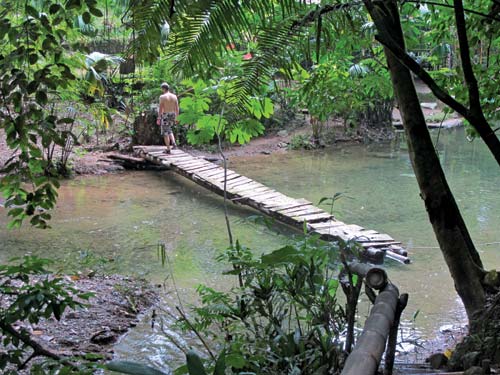
swimming hole on the way to the El Cielo waterfall
The path to Sapzurro leads you through the exuberant rainforest to a lookout point and then down directly to the beach. The hike takes two hours. Start at the soccer field, on the southern end of Capurganá, and ask the way. Midway up the uphill path is a shack that is the home of a man who claims to protect the jungle. Once you find him, you know you’re on the right track. He expects those who pass through to pay him about COP$1,000. At the top of the mountain there is a nice overlook with views of Capurganá and the coastline. The hike is not difficult, but the path can get muddy and slippery in places. Wear hiking boots and pick up a walking stick along the way to help you manage the steep parts.
Once in Sapzurro, you’re a short hike (15 minutes) from the border with Panama and the village of La Miel. This easy walk begins on the same street as Cabañas Uvali and the Reserva Natural Tacarcuná. The border crossing is at the top of a steep hill embedded with steps. You’ll need to show a passport to cross over to Panama. There is not much to the community of La Miel. It has a small military outpost, many young children running around, and a pleasant beach where you can swim and have a seafood lunch or a drink.
As you’d expect, the warm, turquoise waters off the coast of Capurganá, all the way up to San Blas in Panama, make for fantastic diving, and there are over 30 diving sites to choose from. The best time for underwater exploration is from May to November. During those months, visibility is exceptional with hardly any waves. There are coral walls, reef rocks, and caves to explore.
Dive and Green Diving Center (facing the port, cell tel. 311/578-4021 or 316/781-6255, www.diveandgreen.com, 7:30am-12:30pm and 2pm-6pm daily) is the best place to organize a diving trip (certified diver excursion COP$190,000) or to take a five-day PADI certification course (COP$820,000) with a bilingual instructor. For these packages it is best to pay in cash, as credit card transactions have an additional fee. For those interested in snorkeling, Dive and Green can make arrangements for you, though they don’t themselves lead snorkeling trips. Dive and Green offers all the equipment you need. If you are on the fence about whether diving is for you, they offer a Discover Scuba Diving day for COP$150,000. Dive and Green has accommodations, comprising four rooms in a house adjacent to their offices. These cost COP$25,000 per person. The house faces the water, guaranteeing a pleasant evening breeze.
Sol del Darién (cell tel. 318/633-3994) is a recommended tour agency run by a French couple. It offers an interesting menu of excursions in the region, including canoe trips, guided nature walks, and multiday adventures in the San Blas Islands. The owners also operate the hostel La Bohemia.
Hotels are usually the best options for food in both villages. Donde Josefina (Playa Caleta, cell tel. 316/779-7760, noon-9pm daily, COP$30,000) remains the top restaurant for a delicious, gourmet seafood dinner, right on the beach in the heart of Capurganá. Dining on lobster in a coconut-and-garlic sauce under the swaying branches of a palm tree: That sounds like a vacation!
Hernan Patacón (no phone, hours vary, COP$18,000) is a food stand serving fresh fish and shrimp. They are located in front of the town clinic. A decent bakery overlooking the soccer field in the center of town serves breakfast, and is open daily.
In Sapzurro, the best places for a meal are Doña Triny (Hostal Doña Triny, cell tel. 312/751-8626 or 313/725-8362, noon-10pm daily, COP$20,000), a two-story brick house facing the water, and the Gata Negra (cell tel. 314/725-0325, www.lagatanegra.net, open daily) for authentic home-style Italian dishes. Call in advance to let either restaurant know you’re coming.
There are a surprising number of excellent and inexpensive accommodations options in both Capurganá and Sapzurro. While there are a few large, all-inclusive hotels with welcome drinks and the works, the most interesting and comfortable options are the smaller guesthouses and hostels. Nearly all hotels are owned and operated by out-of-towners.
In Capurganá, many hotels and hostels are near the muelle (port), the hub of activity. Many visitors stay at one of the few all-inclusive hotels in Capurganá, but those options lack charm.
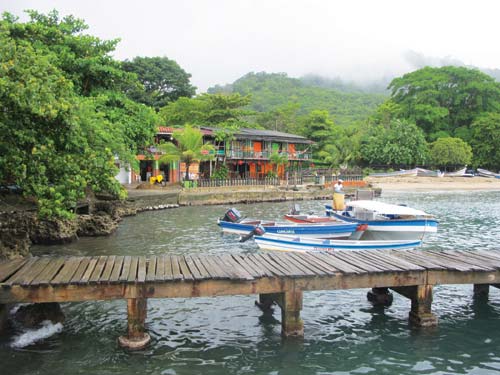
Capurganá is on the edge of the jungle.
One of the best “urban” lodging options in Capurganá is Posada del Gecko (in town, cell tel. 314/525-6037, www.posadadelgecko.com, posadadelgecko@hotmail.com, COP$20,000 dorm, COP$35,000 d), which is run by an Italian-Colombian couple and offers both dorms and private rooms spread over two houses, with a capacity of 28 people. In between the buildings is a spacious garden ideal for lounging in a hammock or the hot tub. Enjoy a good Italian dinner by candlelight at the restaurant (7:30pm-11pm daily); it’s open to nonguests as well, but it’s best to stop by in advance and make a reservation. The hotel can arrange three-day excursions to the San Blas Islands (Panama), in which you visit a Kuna indigenous community, frolic on pristine white-sand beaches, and snorkel.
Several excellent guesthouses reside amid the trees in the Playa Roca area, about a 15-minute walk or horse ride from Capurganá. At night you’ll need no air-conditioner, and in the morning you may awake to birdsong. This is more pleasant than staying in the Centro. Some of the perks of staying at welcoming S Cabañas El Tucán (Playa Roca, www.cabanatucancapurgana.com, COP$65,000), run by a friendly Bogotana-Italian couple, are that the owners make their own pasta and are good cooks. This house in the jungle is clean and comfortable, and the prices of the four spacious rooms are reasonable.
Right across the path from El Tucán is S Cabañas Darius (Playa Roca, cell tel. 314/622-5638, www.cdarius.blogspot.com, capurga05@gmail.com, COP$85,000 pp incl. 2 meals), a very nice guesthouse among the trees. Rooms are spacious and clean, and it’s cool enough at night that you won’t miss air-conditioning. Balconies and hammocks provide lounging space, but the top selling point is the warm hospitality and the good food.
A third option in the same area is Hotel Los Robles (Playa Roca, cell tel. 314/632-8408 or 314/632-8428, COP$120,000 d incl. 2 meals). This lodge has quite the entrance—a winding path lined by bright fuchsia ginger flowers. Caracolí and higuerón trees provide shade and a home for birds. There are 12 rooms in two houses.
The most low-key place to stay in the Capurganá area is Playa Aguacate. The German owner of the S Bahía Lodge (Playa Aguacate, cell tel. 314/812-2727, www.bahia-lodge.com, COP$190,000 pp incl. 2 meals) has carved a little paradise out of the jungle—once there you won’t want to leave. Its simple and comfortable cabins, each with a sea view, are popular with honeymooners and those celebrating special occasions. Over the hill from Bahía Lodge is Hotel Las Ceibas (Playa Aguacate, cell tel. 313/695-6392 or Medellín tel. 4/331-7440, www.hotellasceibas.com). It has three rooms in two houses set amid gardens; the rooms have pleasant balconies with hammocks for late-afternoon relaxation.
La Bohemia (south of town, no phone, www.labohemiahostal.com, COP$20,000 dorm, COP$50,000 private room) is a hostel in a cheerful wooden house with two dorm rooms and two private rooms, with a shared bath. It’s a good choice thanks to the friendly, artsy atmosphere. The hostel is run by the owners of the Sol del Darién tour agency.
In Sapzurro, there are quite a few inexpensive lodging options, but fewer restaurants than in Capurganá. Most hotels offer meals, though, and are usually the best bet, as they tend to be open more frequently. Cabañas Uvali (in town, cell tel. 314/624-1325, COP$40,000 pp) is a friendly, clean, and straightforward little place in town. It’s about a five-minute walk from the beach. La Posada Hostal & Camping (cell tel. 312/662-7599 or 310/410-2245, www.sapzurrolaposada.com, COP$65,000 pp d), close to the path to Capurganá, has one luxury apartment with a view, a dorm-style room, and a large space for camping under a big mango tree. They have a little tiki bar over the water, which can be set up for a romantic dinner under the stars.
The S Resort Paraíso Sapzurro (cell tel. 313/685-9862, COP$10,000 dorm, COP$50,000 pp d) has basic beachfront cabins. This hostel is more commonly known as “Donde El Chileno” (The Chilean’s Place), after the Chilean owner. The hostel can organize oversea transportation directly to Cartagena. Free avocadoes and mangoes are a nice perk. It’s located near the path to Capurganá and the entrance to Sapzurro.
The S Sapzurro Reserva Natural Tacarcuna (on the path to La Miel, cell tel. 314/622-3149 or 320/300-1668, COP$40,000 pp) is a special place for anyone interested in the region’s flora and fauna. The two cabins are cute. The owners, Martha and Fabio, offer a botanical garden of native species with nature trails and a butterfly farm. Their other passion is birds: Go behind the house and up the mountain with a pair of binoculars to spot cuckoos, parakeets, owls, antipittas, tanagers, four different types of toucans, and many other species, along with the throngs of migratory birds that arrive between August and November each year. The owners can organize a number of hikes in the area. Don’t confuse this natural reserve with the all-inclusive Tacurcuna Hotel near the Capurganá airport.
The S Gata Negra (cell tel. 314/725-0325, www.lagatanegra.net, COP$50,000) is a cozy guesthouse that also serves Italian food. It’s surrounded by fruit trees and jungle. There are two rooms with a shared bath and one with a private bath.
Bring extra cash to Capurganá: There are no ATMs, and credit cards are not accepted in most establishments. To avoid bringing wads of pesos, many hotels will allow (or require) you to make a consignación (deposit) to their bank account in advance. That can usually be done from any city in Colombia. The nearest bank, Banco Agrario (Cl. Las Flores with Cl. Consistorial, tel. 4/682-8229, 8am-11:30am and 2pm-4:30pm Mon.-Fri.), is in Acandí, a half-hour boat ride south from Capurganá.
Capurganá and Sapzurro are accessible only by plane or boat. To get here, you have to either take a flight from Medellín to either the Capurganá airport (near the town center) or Acandí airport (10 minutes outside of Acandí) or take a lancha (boat) from Turbo or Acandí. Acandí is the municipality about 17 kilometers (10.5 miles) south of Capurganá. Should the seas be too rough or if a general strike shuts down all transportation options, you may be stuck in the jungle for a couple of days more.
Aerolíneas de Antioquia (www.ada-aero.com.co) serves both Capurganá and Acandí from Aeropuerto Olaya Herera in Medellín. ADA has one flight per day (Mon.-Sat., less than an hour, COP$150,000 and up each way) to Acandí from Medellín. Flights are prone to sell out on long weekends and during high season in December and January and during Semana Santa. The Capurganá airport has been closed for improvements, with an expected reopening in 2017.
To get from Acandí to Capurganá, you’ll have to take a horse-drawn cart from the airport to Acandí’s docks (a 15-minute trip, COP$6,000), from where you’ll take a 30-minute lancha (boat) ride to Capurganá (COP$17,000). There is a lancha departure at 1pm daily. The seas can be rough at times, so try to get a seat in back to avoid too much jostling from the boat’s movements. Keep your camera or other electronics in their cases so they won’t be exposed to seawater. Demand a life vest. The return trip from Capurganá to Acandí generally leaves at 7:30am daily.
All boats arrive at the muelle (docks) in Capurganá, in the middle of town. Most hotels are within walking distance, although those on Playa Roca are a 15-minute walk away. If you have heavy luggage, ask for a horse (about COP$10,000) when you disembark.
Hotels in Playa Aguacate and Sapzurro are reachable only by taking another lancha from the docks in Capurganá, about a 20-minute ride. Those hotels will arrange your transportation from Capurganá in advance.
There are buses from Medellín (eight hours), Montería (four hours), and from cities across the Caribbean coast to the rough port city of Turbo on the Golfo de Urabá. It’s then possible to take a 2.5- to 3-hour boat ride from Turbo to Capurganá or Acandí. These usually depart daily 7am-8am, costing about COP$60,000. The early-morning departure means that you will probably have to spend the previous night in Turbo. That’s not ideal, but most tourists agree that Residencias La Florida (Cra. 13 No. 99A-56, Turbo, tel. 4/827-3531, COP$30,000 d) is an acceptable lodging option. It’s close to the port, and the hotel staff is quite helpful in arranging your onward transportation.
Do not plan to take a boat from Turbo to Capurganá from December to March. The 2.5-hour journey can be awful due to high winds and unrelenting waves. This is likewise true for the trip from Acandí to Capurganá, although it is a much shorter ride.
There is also a direct fast boat service from the town of Necoclí (tel. 4/821-4164 or cell tel. 315/687-4284), which is a convenient option for those coming from Cartagena. It takes 1.5 hours and costs COP$120,000 round-trip. In Necoclí, Hotel Panorama Suite (cell tel. 312/702-0813, hotelpanoramanecocli@gmail.com, COP$40,000 pp d) has 28 rooms and is run by the same people who operate boat transportation to Capurganá.
To return to the mainland from Capurganá, it’s best to reserve a day in advance for lanchas bound for Acandí or Turbo, especially during peak tourist times. Your hotel should be able to do this for you by calling ahead to the muelle, where the contact is Ariel Palacios (cell tel. 312/264-5924).
To travel onward to Panama, you must go to the Colombian Ministerio de Relaciones Exteriores (Cl. del Comercio, Capurganá cell tel. 311/746-6234, 8am-5pm Mon.-Fri., 9am-4pm Sat.) to get an exit stamp before leaving Capurganá.